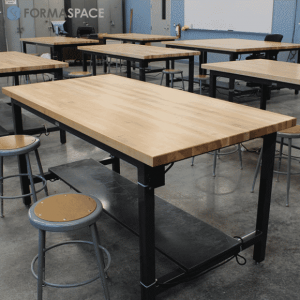
The Impact of the Pandemic on Education
When will things be able to return to normal in schools? Find out what parents and school administrators need to know to stay safe at school.
The 2020-21 academic year was like no other. Now that the school year has passed, we have some early data to assess the impact of the pandemic on learning outcomes.
What happened, and where do we go from here?
Let’s start with learning outcomes during the pandemic.
Nationwide Drop In School Attendance, Especially Among Youngest Students
NCES, the National Center for Education Statistics, reports that nationwide there was a steep 13% drop in public school enrollment for children Pre-K and kindergarten students. Grades 1 – 8 saw a 3% decrease. Grades 9 – 12 held steady, with a 0.4% increase.
High school dropout rates are not yet available, but education analysts expect to find huge increases in dropout rates as well as chronic absences. And a recent McKinsey study estimates that there might be an extra 2.3 – 4.6 million 8 – 12 graders absent from school during the pandemic.
The pandemic may also impact college attendance rates in the future, especially among rural students, where college applications have dropped by 18%. The same McKenzie report estimates that 26% of low-income students have abandoned their plans for attending college.
Three-Quarters Of K-12 Students Received In-Person Instruction
The number of primary school students attending virtual classrooms may be lower than we think.
According to data aggregator Burbio, only 2% of US K-12 students received exclusive “virtual-only” instruction during the 2020-21 academic year; while 28% attended “hybrid” schools, and 70% attended in-person classrooms.
On the other hand, 84% of college students received some of their instruction online, according to the NCES.
Postsecondary school students also saw significant turmoil during the 2020-21 academic year. 40% had financial disruptions (29% lost a job or income), and 28% had to change housing.
Difficulties In Performing Formative And Summative Assessments
Distance and hybrid learning has not only disrupted student curriculum and teaching methods, it also disrupted how teachers and schools perform formative and summative assessments.
Many school districts dropped their requirements for students to take standardized tests due to the risk of bringing large numbers of students together in one place.
The pandemic may also be the death knell for traditional college admissions exams, as more institutions dropped the requirement for SAT (or ACT) college applications, spurring a boom in applications to top-name schools. (Unfortunately, many scholarship applications still rely on these tests, putting financial assistance for students who cannot take these tests in person at risk.)
Academic Achievement Studies Highlight “Learning Loss” During The Pandemic
According to symposium panel hosted by CRPE (Center on Reinventing Public Education), it’s difficult to pinpoint exactly how much of a “learning loss” but the “the evidence suggests students tested in the 2020–21 school year lagged pre-pandemic expectations by an amount roughly equivalent to several months of learning in a typical year.”
This figure correlates well with the McKinsey study mentioned earlier, which projects that by the end of the 2020-21 school year, students were (on average) five months behind in math and four months behind in reading.
Students from lower-income families (particularly with parents with less education and/or full-time jobs) fared poorly compared to those from wealthier backgrounds (especially those attending private schools).
Reading and math achievement dropped significantly during the 2021-21 school year, particularly among elementary grade students in American Indian, Alaska Native (AIAN), Black, and Latino communities, as well among those attending high-poverty schools, according to a report from the Center for School and Student Progress.
Course failure rates increased overall, particularly among low-income households and students of color.
On the other hand, distance learning has delivered some unexpected positive results as well.
For example, some special needs students seem to have benefited from distance learning, including those with disability/mobility issues or social interaction issues, such as certain students on the autism spectrum.
Education Strategies To Address Learning Loss Due To The Pandemic
Schools are seeking ways to help students “catch up” by coming up with creative solutions that go beyond the traditional “credit recovery” strategy used prior to the pandemic.
Some of the strategies that school districts are pursuing include launching new tutoring programs (in some cases by partnering with private companies); extending the academic school year; encouraging students to read materials at their expected grade level; partnering with community organizations who can provide additional education resources; and asking parents to help boost literacy activities at home.
The Effect Of The Pandemic On Teachers, Students, And Families
Zoom Burnout
Parents of school-aged children talk about Zoom fatigue and Zoom burnout.
But is Zoom burnout real?
According to a major study by Microsoft, looking at a screen for hours at a time (such as on a Zoom call) does increase fatigue and stress.
Researchers at Microsoft’s Human Factors Lab used EEG Caps on 14 volunteers to measure beta wave activity (associated with stress) and found that the longer you stay focused on a screen, the higher the levels of stress.
One solution is to take regular breaks (to allow time to recover) and avoid back-to-back virtual meetings. You can also switch to audio calls or email correspondence where possible (it’s less stressful), as well as avoid multi-tasking.
Socialization And Emotional Development
But for parents of young children participating in online learning at home, the term Zoom fatigue encompasses more than just managing screen time – kids need to be supervised, fed meals, and often separated from one another to keep the peace.
This is a burden that, according to a Brookings Institution report, disproportionally falls on mothers. Another study estimates that mothers with young children have had to reduce their work hours four to five times more than fathers during the pandemic.
But is it working?
Read more...
Julia Solodovnikova
Formaspace
+1 800-251-1505
email us here
Visit us on social media:
Facebook
Twitter
LinkedIn
EIN Presswire does not exercise editorial control over third-party content provided, uploaded, published, or distributed by users of EIN Presswire. We are a distributor, not a publisher, of 3rd party content. Such content may contain the views, opinions, statements, offers, and other material of the respective users, suppliers, participants, or authors.




